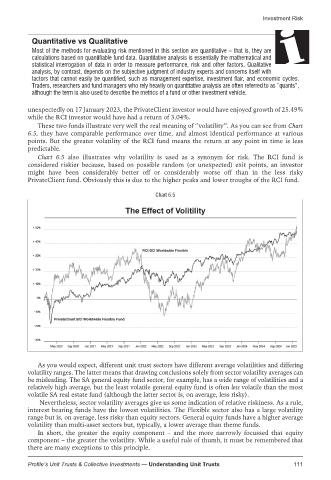Page 113 - Profile's Unit Trusts & Collective Investments - March 2025
P. 113
Investment Risk
Quantitative vs Qualitative
Most of the methods for evaluating risk mentioned in this section are quantitative – that is, they are
calculations based on quantifiable fund data. Quantitative analysis is essentially the mathematical and
statistical interrogation of data in order to measure performance, risk and other factors. Qualitative
analysis, by contrast, depends on the subjective judgment of industry experts and concerns itself with
factors that cannot easily be quantified, such as management expertise, investment flair, and economic cycles.
Traders, researchers and fund managers who rely heavily on quantitative analysis are often referred to as “quants”,
although the term is also used to describe the metrics of a fund or other investment vehicle.
unexpectedly on 17 January 2023, the PrivateClient investor would have enjoyed growth of 25.49%
while the RCI investor would have had a return of 3.04%.
These two funds illustrate very well the real meaning of ‘’volatility’’. As you can see from Chart
6.5, they have comparable performance over time, and almost identical performance at various
points. But the greater volatility of the RCI fund means the return at any point in time is less
predictable.
Chart 6.5 also illustrates why volatility is used as a synonym for risk. The RCI fund is
considered riskier because, based on possible random (or unexpected) exit points, an investor
might have been considerably better off or considerably worse off than in the less risky
PrivateClient fund. Obviously this is due to the higher peaks and lower troughs of the RCI fund.
Chart 6.5
As you would expect, different unit trust sectors have different average volatilities and differing
volatility ranges. The latter means that drawing conclusions solely from sector volatility averages can
be misleading. The SA general equity fund sector, for example, has a wide range of volatilities and a
relatively high average, but the least volatile general equity fund is often less volatile than the most
volatile SA real estate fund (although the latter sector is, on average, less risky).
Nevertheless, sector volatility averages give us some indication of relative riskiness. As a rule,
interest bearing funds have the lowest volatilities. The Flexible sector also has a large volatility
range but is, on average, less risky than equity sectors. General equity funds have a higher average
volatility than multi-asset sectors but, typically, a lower average than theme funds.
In short, the greater the equity component – and the more narrowly focussed that equity
component – the greater the volatility. While a useful rule of thumb, it must be remembered that
there are many exceptions to this principle.
Profile’s Unit Trusts & Collective Investments — Understanding Unit Trusts 111

